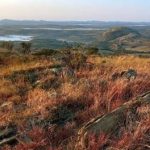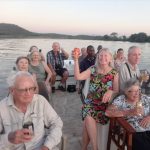TREE LIFE 519
NOVEMBER 2023
FUTURE EVENTS
Saturday 28th October:- Tony Alegria will host a special Saturday walk for members who want to know what trees which should be found at Kanyemba can also be found in the National Botanical Gardens. Meet at 8.30 in the car park.
Thursday 2nd – Monday 6th November 2023:- Tree Society Trip to Kanyemba. This trip is fully subscribed so many thanks to Francis Morris for organising it. It should be very exciting for those of us who brave the November heat in the valley.
Saturday 4th November 2023:- visit to the National Botanical Gardens. Meet at 8.30 in the main car park and join Tony for an interesting morning with the trees we can see there.
Saturday 25th November 2023:- we meet at 2.30 p.m. for an exploration into the trees at the former home of Ann Sinclair. More details on the Tree Society’s WhatsApp Group.
REPORTS FROM PREVIOUS OUTINGS
A TRIP TO THE GREAT DYKE, 11-14 JULY 2023 (A sideline to Bird Watch), PART 3
Text and photos by Ian Riddell
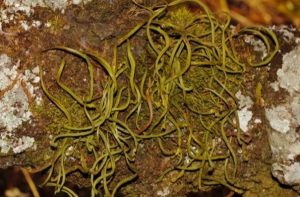
An unidentified Fern
Day 3: 13th July
Our in-the-dark start saw us driving the steep track back to O.P. 1 in the north of the Mpinga section of the Great Dyke. Another cold and windy day meant no birds were seen. Having got my eye in for Fadogia homblei yesterday evening I saw much greener ones were spread amongst the miombo here, too. A fern with long narrow leaves was growing amongst orchids on a dwarf msasa. It is probably from the Polypodiaceae family.
After our allotted 3 hours we then drove all the way back to the south O.P. It is worth mentioning that on our toing-and-froing on the track west of Chikonyora I had noticed that many of the largest Great Dyke raisin-berry trees Ozoroa longipetiolata had been cut in the past, some now coppicing.
At the O.P. we decided to explore the track that continued past it but it only went a short distance before ending at a very steep drop-off overlooking the farms. We decided to do a transect along the lower slopes of the dyke that started with an Augur Buzzard and after some 600 m we came to a heavily but narrowly wooded valley – it was riverine heavy with Syzygium with a patch of acacia at the top, above a spring.
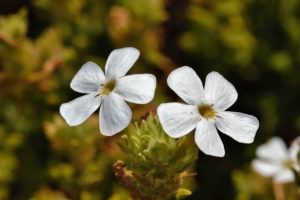
Jamesbrittenia fodina
A large Cussonia spicata grew on the dividing line between wet and dry, plus a Lance-leaved waxberry Myrica serrata on the side of cattle paths. Down in the gully was some bracken amongst the little waterfalls with lots of black plastic piping leading down to kraals below. The bird life abounded at this little oasis.
We climbed back up and over the serpentine hills and southeast through wooded grassland overlooking the chrome-mined area on a circuit back to the vehicle, finding Jamesbrittenia fodina on the east-facing slopes overlooking the farmlands. The pretty white flowers had purple streaks around the corolla.
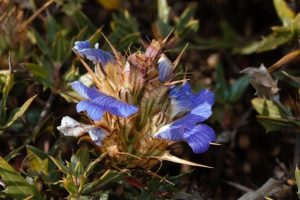
Blepharis subvolubilis
Then it was back up the O.P. for an afternoon survey that produced only Pied Crow and Augur Buzzard, but more exploring for plants gave me a Blepharis subvolubilis with blue flowers and a Kalanchoe sp.
There were a few more Galpin’s Firelily tucked amongst the rocks, a lot more Euphorbia memoralis and Euphorbia wildii, some sprouting new leaves.
Day 4: 14th July
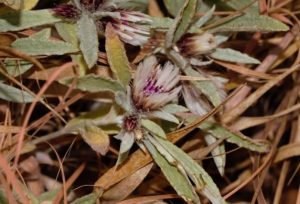
Dicoma niccolifera
Our early morning O.P. was back on the same hill. It was freezing again with the cloud ceiling right down and wind-borne clouds streaking through the valleys below us! By 08h30 the clouds let us peek beneath their skirts but the higher miombo ridge was still cloaked – bad news for the others on the high north O.P. but I’m sure the orchids up there were enjoying the moisture-laden winds!
Later explorations produced Dicoma niccolifera, a furry-leaved Asteraceae, a near-endemic and mostly found on serpentine.
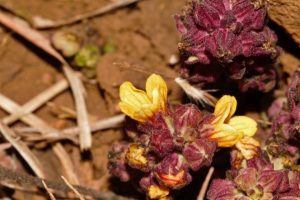
Alectra sp.
At the end of our bird watch, which was the best so far with African Goshawk, Augur Buzzard, Lanner Falcon and Black Stork, I took one of our team mates to the spring. In the saddle north of our hill was Alectra sp., pretty in purple and yellow but not easy to ID to species (right).
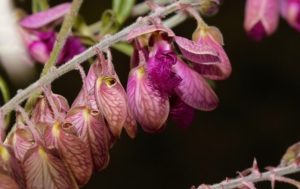
Polygala virgata decora
Down at the spring was a flowering Showy Purple False-pea Polygala virgata decora (left).
In the same saddle that afternoon I went to photograph a plant we saw in the morning – it was Heteromorpha involucrata with yellow flowers in densely flowered double umbels ranging from buds to flowers to seeds on the same plant.
A small Purple-wood Dalbergia, Dalbergia nitidula nearby had the galls typical of this species. Also down here I found another blue-flowered Blepharis subvolubilis but this was only the second example amongst all the white ones.
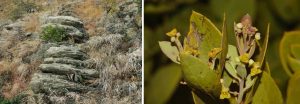
Erythroxylum emarginatum amongst windswept rocks and a budding and flowering Osyris lanceolata
Climbing up the rocky north side of the hill were a few African coca trees Erythroxylum emarginatum in shrub form and the Rock tannin-bush Osyris lanceolata, some smaller ones with a few yellow fruits. The thick, leathery leaves are topped with a sharp tip.
The other half of our team had left around lunchtime to catch the evening flight to Jo’burg, spotting a Secretarybird in the serpentine on the way out. We left at 16h00 tackling the evening traffic to and from Harare, our afternoon birds being Brown Snake-eagle and a few more Lanner Falcons. This was the end of an interesting visit to the Great Dyke with lots of new endemics and more to find on future trips.
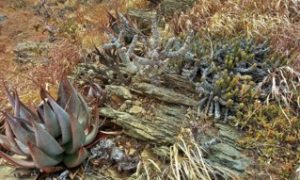
Dyke Aloe, a Xerophyta, Wild’s euphorbia, Euphorbia memoralis and Blepharis subvolubilis growing together.
THE TREE SOCIETY FUN DAY AT EWANRIGG BOTANICAL GARDENS
17 SEPTEMBER 2023
Text and photos: Ian Riddell
Following on from a suggestion mooted at the A.G.M. at Art Farm, the committee organised the society’s first-ever Fun Day at Ewanrigg. So, on 17 September, some 30 members and families gathered at the disused restaurant on a dry and warm morning (later leaning to rather hot for some) at around 10 a.m. for tea or coffee and eats.
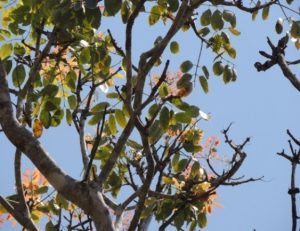
Red Mahogany – just in case
Scavenger Hunt
We weren’t permitted to dilly-dally too long and Tony got us on track for the first event on the programme, issued us with large plastic bags and general directions and sent us out on the scavenger hunt.
Each of the four teams had 30 trees to find on the list, both indigenous and exotic, with evidence of some kind to be popped into the bag for later scrutiny. Our first challenge was that the Red Mahogany was a tall tree – and so were all the others we subsequently found – so I took a photo for insurance.
Later, under the large trees near the aloes, much searching produced the one and only fruit in the gardens, so we could disregard the dried leaves we had picked up.
Other challenges were the exotics, some of which we never saw and after our return, I spotted a 15 cm tall jacaranda sprouting near the restaurant.
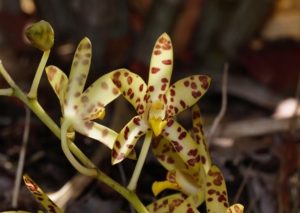
A Leopard Orchid Ansellia africana
What we did see was this spectacular Leopard orchid but sadly it did not count as part of the hunt.
Whilst venturing out with Ken to see what raptor was nesting in the tall gums nearby there was also an obvious tamarind right by a road, so it turned out that the teams needed to have covered both the areas Tony mentioned to meet all the challenges.
But we had to be back by noon so there wasn’t enough time and the planned walk to view the plaque dedicated to Harold Basil Christian was also shelved – it was quite hot by now and some of us had seen it previously. By coincidence, our team came across it on the scavenger hunt and it was the first time I’d seen it, despite quite a few previous visits to the gardens. You can read a bit more about the history of Ewanrigg in Tree Life 340.
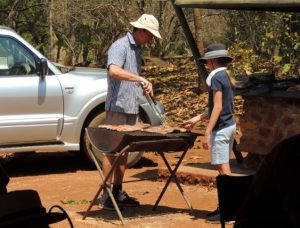
Ryan and daughter Cassy busy at the braai
The teams scored quite well: the lowest was 16, then two got 20 and the winner got 27 (but deducting 2 for unreadable text gave 25). All the species were found by one team or another and we all enjoyed the fun challenge.
As Mark and Meg were vetting the finds, the cooks were busy in the hot sun tending the braais whilst the rest socialised and relaxed. The impressive spread was laid out, with wine, and everyone dug in, with plenty for seconds, thirds and enough leftover meat to satiate a stray lion.
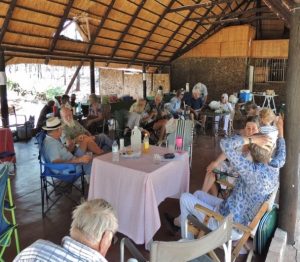
‘You’re not drunk if you can lie on the floor without holding on’?
After lunch we broke up into teams of 5-6 or so for the Fun Quiz, compiled and run by Bill. There were 100 questions and the teams all scored highly. One question that took the fancy of many was:
“Who said ‘You’re not drunk if you can lie on the floor without holding on’?”
Some of the teams got the answer, or at least those that were enjoying the wine, which was Dean Martin!
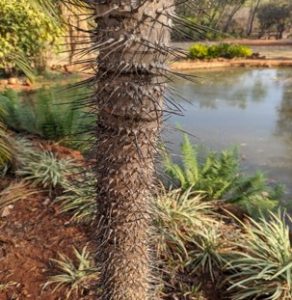
Ruffle Palm, Aiphanes horrida
Ruffle Palm Aiphanes horrida. By latish afternoon we all started trickling home. Mark and I wandered a bit and noticed a most interesting palm with impressive spines all over – not a tree-huggers species, though! It was Aiphanes horrida, a species native to northern South America and Trinidad and Tobago. It is mentioned on the Flora of Zimbabwe website but without any known records, so it can now be added!
A big thank you to Bill, Fiona and the committee for organising the Fun Day and also to those who brought snacks, cakes and the like for the tea/coffee breaks. I’m sure everyone will vote Yes!! for another one next year.
NATIONAL BOTANICAL GARDEN OUTING 7TH OCTOBER 2023
By Tony Alegria
Only six of us turned up for this tree walk, namely Ann Sinclair, Barbara Maasdorp, Jan van Bel, Jim Dryburgh, Mark Hyde and myself. I wanted to see if the Albizia zimmermannii and the Erythrina latissima were in flower, but the mission for the day was to find trees in flower to try to identify which type of inflorescence they had. Although the pictures below look clear-cut – we certainly didn’t find that!
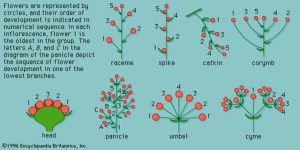 Although some inflorescence did resemble those in the diagram, some were kind of in-between two of them and some were just totally confusing!
Although some inflorescence did resemble those in the diagram, some were kind of in-between two of them and some were just totally confusing!
The Sclerocarya birrea. Marula definitely had many spikes and it was noted that there were only male flowers on them.
The Combretum hereroense. Mouse-eared combretum and the Combretum zeyheri definitely had racemes but the Combretum microphyllm (Creeping fire bush) did not. Instead, it had two or three single flowers on stalks at each node (the case of a single flower is not featured in the above).
The Eucalyptus torelliana; Cadaghi appeared to have panicles but it was difficult to decide what was what!
The Xeroderris stuhlmannii, Wing pod had white pea-shaped flowers but once again the inflorescence type was indeterminate.
The Vachellia (Acacia) erioloba. Camel thorn was just about in the last stage of producing globose flowers which in fact are umbels with minute flowers radiating in all directions.
The Albizias have shaving brush flowers with no petals, these too are umbels but only radiate upwards.
The Albizia zimmermannii. Woodland long-pod Albizia was in flower and what a sight, the whole tree down to knee-high level was covered in flowers! What was amazing about this rather large tree was that when the flowers age, they turn a very attractive pinky brown. Why we have never seen this tree in flower before is really weird, perhaps we just have not walked past it before when it has been in full bloom. It has flowered before as indicated by the pods we have seen many times.
Near the Herbarium is a large Albizia schimperiana. Forest long-pod Albizia which was also full of flowers, but something I had not noticed before is that had a very delicate perfume!
The unknown! The most puzzling flowers we looked at belonged to the Cordyla africana. Wild mango all of which were flowering in profusion. We didn’t actually look at the flower arrangement as something weird was going on here:-
The flower resembles a cup which had copious nectar, many orange stamens on the brim but had no female parts! Yet the older, wilted flowers on the same tree had what looked like female parts which were actually developing fruit emanating from the centre of the flower cup where there was nothing but nectar before! This needs further investigation!
Investigations via Flora Zambesiaca reveal that the trees can bear either male or bisexual flowers. It was thought that the empty cups were male flowers and the ones with developing fruit bisexual, however the question remains, can the tree have both male-only and bisexual flowers on 1 plant?
It was noted that none of the Erythrinas: Erythrina abyssinica, Erythrina livingstoniana or the Erythrina lysistemon were in flower (spikes). There was a debate around the tree labelled Erythrina latissima (the Broad-leaved coral-tree) where the flowers were either too high to reach or had fallen to the ground. Mark, having examined fallen petals, mentioned that the petals just looked too small to be an E. latissima. This is one tree we will definitely keep an eye on!
OUTING TO STAPLEFORD FARM 15TH OCTOBER 2023
Text and photos by Tony Alegria
Barbara Maasdorp, Jan van Bel, Jim Dryburgh, John Lawrence, Mark Hyde and myself duly arrived at the meeting place and shared transport to the farm. The day was partly cloudy and a very pleasant temperature and as instructed, we phoned Rob Davenport when we were passing by the Charles Prince turn-off and were met at the gate by him.
We proceeded to the farmhouse where Rob told us about the farming operation and pointed out a hill about one and a half kilometres from the farmhouse which only had small trees. He told us that some time back, settlers had occupied the hill, cut down all the sizeable trees and then left the area. For the last two years or so, Rob has planted some six to seven hundred trees on the hill and will continue to do so for a while.
Our mission for the day was to identify and label as many trees as we could in the time we were there.
Rob knew some of the trees but needed help in identifying the majority of them. He was equipped with white labels that you write a number on and they have a way of wrapping and locking onto a small branch. This is the quickest way of labelling trees on a temporary basis before permanent labels can be sourced and affixed to the trees. Jan van Bel was the scribe and noted what number represented which tree, the resulting list he emailed to Rob on the same day. I just hope that the numbers on the temporary labels didn’t wash off with the rains that followed a couple of days later!
It must be noted that natural regeneration (coppicing) has taken place and if managed properly, many of the trees will become 6 metres plus within a couple more years – some of them are presently 4-5 metres tall. The planted trees we saw ranged anything from 1 to 3 metres tall but we only saw a few of these as the hill covers quite a large area. Once the trees mature, they will become a very welcome sight. Rob has planted a mix of indigenous and exotic trees because, as a general rule, exotic trees have more showy flowers than the local trees.
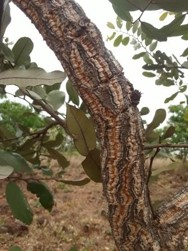
Paranari Curtatellifolia
When we reached our first botanizing spot we were surprised to see a table and chairs on the side of the hill. The table had a cooler box with drinks and a large tray with sandwiches which were appreciated by all.
A young Mbola plum tree (Parinari curatellifolia) had very interesting, colourful new bark. Corky bark means that a tree can withstand bushfires as the bark is a good heat insulator and turns black whilst protecting the tree.
There were a couple of unknown trees of which Mark took samples to compare with Herbarium specimens. One tree was labelled Israeli tree – has anybody heard of this tree?
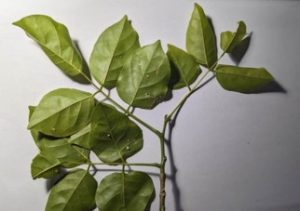
The Israeli tree
Note from Mark: this tree could be Pongamia pinnata, the Indian beech or Pongame oil tree. This is rather rarely cultivated in Zimbabwe and is native to tropical Asia. Flowers or fruit would be needed for confirmation.
We intend to return to look at more trees once Rob has permanent labels on them to replace the temporary labels. We need to have many spare numbered labels so we can use them as we identify more trees. It is also to be noted that at present there are very small trees that cannot take a nail to secure the label, and the labels will have to hang from a wire!
It was a good day and we returned to the meeting point during lunchtime to return home shortly thereafter.
SHORT NOTES
WHITE JACARANDAS AND THE TREE SOCIETY
From Tree Life, Tree Society WhatsApp group with photo by Karl van Laeran
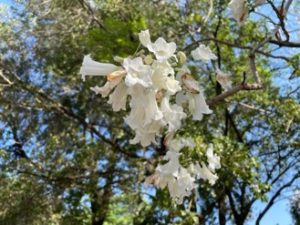 Looking back at Tree Life, articles about Jacarandas and their history have appeared in most years as they flower. This from November 2021 (Number 495) by Tony Alegria:
Looking back at Tree Life, articles about Jacarandas and their history have appeared in most years as they flower. This from November 2021 (Number 495) by Tony Alegria:
“The first jacaranda trees (purple) to be planted in Harare were brought in from the botanical gardens in Durban by a honeymooning couple who brought in six seedlings way back in 1899.”
We now have the following from Anne Sinclair
“The seeds of the White Jacaranda were a gift to the city of Salisbury in 1961 from a Dr Stewart from California. He was a friend of my Uncle who lived in Pasadena. I met Dr Stewart when he came here.”
EDITOR’S COMMENTS
As a new editor am taking this opportunity to introduce myself formally. As a child, I learnt my birding knowledge by osmosis from my father Dick Harwin. As Mark’s wife, I have learnt the small amount of botanical knowledge I possess also by osmosis. I have to thank you all for this opportunity to spread myself verbally as well as being the first to read your contributions and to introduce the new section:- “Short Notes”. Please can I have any notes of chance meetings, whether with trees or people, to expand the scope of Tree Life.
TREE SOCIETY COMMITTEE AND CONTACTS
Chairman Tony Alegria tonyalegria47@gmail.com 0772 438 697
Honorary Treasurer Bill Clarke wrc@mweb.co.zw 0772 252 720
Projects Jan van Bel jan_vanbel@yahoo.com 0772 440 287
Venue Organiser Ann Sinclair jimandannsincs@zol.co.zw 0772 433 125
Committee Member Ryan Truscott ryan.kerr.truscott@gmail.com 0772 354 144
Secretary Teig Howson teig.howson@gmail.com 0772 256 364
Tree Life Editor Linda Hyde Lmharwin@pentact.co.zw 0772 232 075
Technical Editor Mark Hyde mahyde@gmail.com 0772 233 751
Tree Society Website https://treesociety.org.zw/
Tree Society Facebook https://www.facebook.com/groups/ztreesociety/
Flora of Zimbabwe: https://www.zimbabweflora.co.zw/
Flora of Tropical Africa: https://plants.jstor.org/collection/FLOTA


